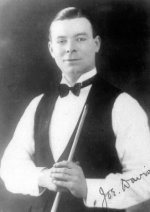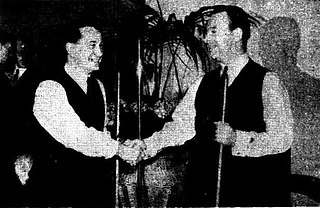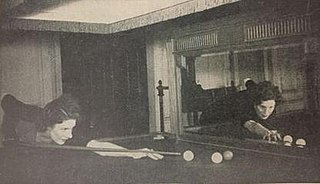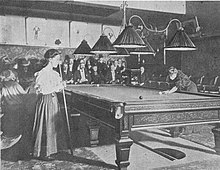
Joseph Davis was an English professional snooker and English billiards player. He was the dominant figure in snooker from the 1920s to the 1950s, and has been credited with inventing aspects of the way the game is now played, such as break-building. With the help of equipment manufacturer Bill Camkin, he drove the creation of the World Snooker Championship by persuading the Billiards Association and Control Council to recognise an official professional snooker championship in 1927. Davis won the first 15 world championships from 1927 to 1946, and he is the only undefeated player in World Snooker Championship history. In 1930, he scored the championship's first century break.
The 1927 World Snooker Championship was a snooker tournament held at several venues from 29 November 1926 to 12 May 1927. At the time, it was titled the Professional Championship of Snooker but it is now recognised as the inaugural edition of the World Snooker Championship. The impetus for the championship came from professional English billiards player Joe Davis and billiard hall manager Bill Camkin, who had both observed the growing popularity of snooker, and proposed the event to the Billiards Association and Control Council. Ten players entered the competition, including most of the leading English billiards players. The two matches in the preliminary round were held at Thurston's Hall in London, and the semi-finals and final took place at Camkin's Hall in Birmingham. The players involved determined the venues for the quarter-finals, resulting in matches in London, Birmingham, Nottingham and Liverpool.
The 1928 World Snooker Championship was a professional snooker tournament held at various venues from 28 December 1927 to 17 May 1928. It was the second staging of the World Snooker Championship. It was played on a challenge basis with the other six entrants playing off for the right to challenge defending champion Joe Davis in the final. The final was held at the Camkin's Hall in Birmingham, England, with three of the other matches contested there, and one each played in Leamington Spa and Nottingham.
The 1929 World Snooker Championship, known at the time as the Professional Championship of Snooker, was a snooker tournament held between 17 December 1928 and 7 March 1929 at various venues in England, with the final taking place from 4 to 7 March 1929 at the Lounge Hall, Nottingham. Defending champion Joe Davis won the title for the third time by defeating Tom Dennis by 19 frames to 14 in the final, after securing a winning margin at 17–12.
The 1930 World Snooker Championship, known at the time as the Professional Championship of Snooker, was a snooker tournament held between 17 March and 23 May 1930 at various venues in England, with the final taking place from 19 to 24 May at Thurston's Hall, London. Defending champion Joe Davis won the title for the fourth time by defeating Tom Dennis by 25 frames to 12 in the final.
The 1931 World Snooker Championship was a snooker tournament held at the Lounge Hall in Nottingham, England from 27 April to 1 May 1931. Despite increasing interest in the game of snooker, only two players entered the competition for the title: defending champion Joe Davis and three-times runner-up Tom Dennis. It was the fifth time that the World Snooker Championship had been contested since its inception in 1927. Davis won his fifth World title by defeating Dennis 25–21. Dennis led 19–16 at one stage but Davis won 9 of the next 11 frames to take the title. The highest break of the match was 72, compiled by Davis in the 41st frame.
The 1932 World Snooker Championship, known at the time as the Professional Championship of Snooker, was a professional snooker tournament that took place from 14 to 20 April 1932, with the final being held at Thurston's Hall in London, England. It is recognised as the sixth edition of the World Snooker Championship. The defending champion, Joe Davis from England, won the title for the sixth time by defeating New Zealander Clark McConachy by 30 frames to 19 in the final. The score when Davis achieved a winning margin was 25–18, with dead frames played afterwards. Davis set a new Championship record break of 99 in the 36th frame of the final. McConachy had become the first player from outside the British Isles to enter the championship. The only other participant was Tom Dennis, who was defeated 11–13 by McConachy in the semi-final at Skegness.
The 1934 World Snooker Championship, known at the time as the Professional Championship of Snooker, was a snooker tournament held partly at the Lounge Hall in Nottingham and then at the Central Hall in Kettering, from 2 to 6 April 1934. Joe Davis won the title for the eighth time by defeating Tom Newman, the only other entrant, by 25 frames to 22. At one stage Newman led 14–13, but Davis then pulled ahead to lead 24–18 and, although Newman won the next four frames, Davis took the 47th frame to secure the title. Davis compiled a break of 70 in the third frame.

The 1946 World Snooker Championship was a professional snooker tournament held from 4 February to 18 May 1946. Joe Davis won the title by defeating Horace Lindrum by 78 frames to 67 in the final, although the winning margin was reached at 73–62. It was Davis's fifteenth championship win, maintaining his unbeaten record in the tournament since its first edition in 1927. The highest break of the event was 136, a new championship record, compiled by Davis in the final.
The 1947 World Snooker Championship was a professional snooker tournament that took place from 20 January to 25 October 1947. The final was held at the Leicester Square Hall in London, England, from 13 to 25 October. The semi-finals were completed in March, but the final was delayed due to building works at the venue, which had been bombed in October 1940. Walter Donaldson won the title by defeating Fred Davis by 82 frames to 63 in the final, although he reached the winning margin earlier, at 73–49. Davis made the highest break of the tournament with a 135 clearance in frame 86 of the final.
Albert Francis Cope was an English professional billiards and snooker player. He played in the 1927 and 1928 World Snooker Championships. In his 1927 semi-final match against Joe Davis he scored a 60 break for which he later received a commemorative certificate.

Joyce Gardner (1910–1981) was an English professional English billiards player. She was the Women's Professional Billiards Champion from 1931 to 1933, and from 1935 to 1938.

Ruth Harrison was an English snooker and billiards player. She won the Women's Professional Snooker Championship each year from its inception in 1934 to 1940, and again when it was next held, in 1948. She also won the Women's Professional Billiards Championship three times.
The Women's Professional Snooker Championship was a snooker tournament organised by the Women's Billiards Association. Held ten times, the event was first played from 1934 to 1941, and again from 1947 to 1950. Across all ten editions, only four players reached the final. Ruth Harrison won eight of the events, with Agnes Morris and Thelma Carpenter winning the others.
The Women's Professional Billiards Championship was an English billiards tournament held from 1930 to 1950. The tournament was first organised by Burroughes and Watts in 1930 and 1931, before the WBA ran the event until its conclusion in 1950. Joyce Gardner won the tournament on seven of the fourteen times that it was held, and was runner-up six times; the only time that she was not in the final was the 1940 tournament. The other players to hold the title were Thelma Carpenter who won four times, and Ruth Harrison who took three championship titles. Harrison's break of 197 in 1937 remains a women's record in competitive billiards.

Thelma Carpenter was an English billiards and snooker player. She won the Women's Professional Billiards Championship three times, and the Women's Professional Snooker Championship once.
The Women's Billiards Association (WBA), founded in 1931 and based in London, United Kingdom, was the governing body for women's English billiards and snooker, and organised the Women's Professional Billiards Championship and Women's Professional Snooker Championship as well as amateur and junior competitions. The founding meeting was held on 13 May 1931 at the Women's Automobile and Sports Association. The meeting was chaired by Teresa Billington-Greig and appointed Viscountess Elibank as the first president and Mrs Longworth as the first chairman. The WBA ran amateur and professional billiards competitions starting from 1932, an amateur snooker tournament from 1933, and a professional snooker championship from 1934.

Margaret Lennan was a Scottish snooker and billiards player. She was runner-up in the 1936 Women's Professional Billiards Championship.
The Billiards and Snooker Control Council (B&SCC) was the governing body of the games of English billiards and snooker and organised professional and amateur championships in both sports. It was formed in 1919 by the union of the Billiards Association and the Billiards Control Club.
The World Women's Billiards Championship is an English billiards tournament, first held in 1931 when organised by the cue sports company Burroughes and Watts then run from 1932 by the Women's Billiards Association (WBA). It is currently run under the auspices of World Billiards Ltd (WBL), a subsidiary company of the World Professional Billiards and Snooker Association.







